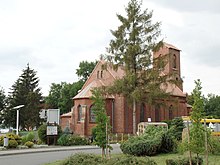Głębinów
| Głębinów Glumpenau |
||
|---|---|---|

|
|
|
| Basic data | ||
| State : | Poland | |
| Voivodeship : | Opole | |
| Powiat : | Nysa | |
| Gmina : | Nysa | |
| Geographic location : | 50 ° 28 ' N , 17 ° 16' E | |
| Height : | 220 m npm | |
| Residents : | 260 (December 31, 2018) | |
| Telephone code : | (+48) 77 | |
| License plate : | ONY | |
| Economy and Transport | ||
| Next international airport : | Wroclaw | |
Głębinów (German Glumpenau ) is a village in the rural municipality of Nysa (Neisse) in Poland . It is located in the powiat Nyski (Neisse district) in the Opole Voivodeship .
geography
Geographical location
Głębinów is located in the southwest of the historical region of Upper Silesia . The place is about four kilometers west of the municipality and the district town of Nysa and about 60 kilometers southwest of the voivodeship capital Opole .
Głębinów is in the Nizina Śląska (Silesian Plain) within Dolina Nysy Kłodzkiej (Glatzer Neisse Valley) . The village is located on the north bank of the Jezioro Nyskie ( Neiss reservoir ).
Neighboring places
Neighboring towns of Głębinów are Goświnowice ( Friedenthal-Großgiesmannsdorf ) in the north and Nysa ( Neisse ) in the east .
history
According to the founding deed of 1310, 18 Flemish hooves from an older Slavic settlement were exposed under German law in Glumpengov . The rural properties were laid out in the form of Franconian homesteads. According to the "Liber fundationis episcopaius Vratislaviensis" the place had 36 hubs, 2 bars and 1 mill with 2 wheels. The lower village was frequently hit by the Neisse floods; a dam later protected it only temporarily.
In 1428 the Hussites raided the village. In 1633 there was a plague epidemic.
In 1731 a chapel with the patronage of St. Urban consecrated for worship in winter. After the First Silesian War in 1742, Glumpenau and most of Silesia fell to Prussia . In 1784 there was a schoolmaster's house in the village.
During the siege of Neisse in 1807, enemy troops were constantly in the place. After the reorganization of the province of Silesia , the rural community of Glumpenau belonged to the district of Neisse in the administrative district of Opole from 1816 . In 1845 there was a chapel, a Catholic school, an inn and 98 other houses in the village. In the same year, 513 people lived in Glumpenau, six of them Protestants. The two-storey school house dates from 1857. In 1865 the place had 15 farms, 32 gardeners and 41 cottagers. In 1866 the chapel was replaced by a neo-Gothic church. In 1874 the district of Großgiesmannsdorf (Kr. Neisse) was founded, which consisted of the rural communities Gießmannsdorf, Glumpenau, Jentsch, Nowag and Stephansdorf and the manor districts of Gießmannsdorf, Glumpenau, Jentsch, Nowag and Schilde. In 1885 Glumpenau had 824 inhabitants.
Since 1923 the place was an independent curate . In 1925, 96 children attended the three-class school. In 1933 there were 755 people living in Glumpenau. In 1937 there were two bakers, two fishermen, three inns, two general stores, a timber shop, a gravel dredging, two basket makers, a restaurant, a blacksmith, a tailor, a shoemaker and an electricity cooperative in the village. In 1939 there were 753 people living in Glumpenau. Until 1945 the place was in the district of Neisse .
In 1945 the place came under Polish administration and was renamed Domaszkowice, the population was expelled. In 1950 Domaszkowice came to the Opole Voivodeship. Between 1969 and 1971 the Jezioro Nyskie ( Neiss reservoir ) was built south of the village . In 1999 the place came to the re-established Powiat Nyski . In 2011, 635 people lived in the village.
Residents and houses
1784: 325 inhabitants, 35 jobs
1845: 513 inhabitants, 98 houses
1895: 744 inhabitants, 121 houses, 176 households
1939: 753 inhabitants, 193 households
2007: 191 inhabitants
Attractions
- The Roman Catholic St. Urban Church (Polish Kościół św. Urbana ) was built in 1866 in the neo-Gothic style. It is located directly on the banks of the Neiss reservoir.
Sons and daughters of the church
- Sepp Klose (1925–2000), German director and actor
Web links
Individual evidence
- ↑ Liczba mieszkańców w Gminie Nysa (Polish), Dec. 31, 2018, accessed on Nov. 11, 2019
- ^ Johann Georg Knie : Alphabetical-statistical-topographical overview of the villages, spots, cities and other places of the royal family. Preuss. Province of Silesia. Breslau 1845, p. 162.
- ↑ Cf. Felix Triest: Topographisches Handbuch von Oberschlesien. Breslau 1865, p. 1156.
- ↑ territorial office district Großgiesmannsdorf (Kr. Neisseblick)
- ↑ AGoFF circle Neisse
- ^ A b Michael Rademacher: German administrative history from the unification of the empire in 1871 to the reunification in 1990. Neisse district (Polish Nysa). (Online material for the dissertation, Osnabrück 2006).
- ^ CIS 2011: Ludność w miejscowościach statystycznych według ekonomicznych grup wieku (Polish), March 31, 2011, accessed on April 3, 2019
- ↑ Franz-Christian Jarczyk: The villages of the Neisse district. Hildesheim: Self-published by the Neisser Kultur- und Heimatbund. 1982. pp. 83ff.
- ^ Website of the municipality of Nysa, Miasto i Gmina , accessed on March 24, 2011


